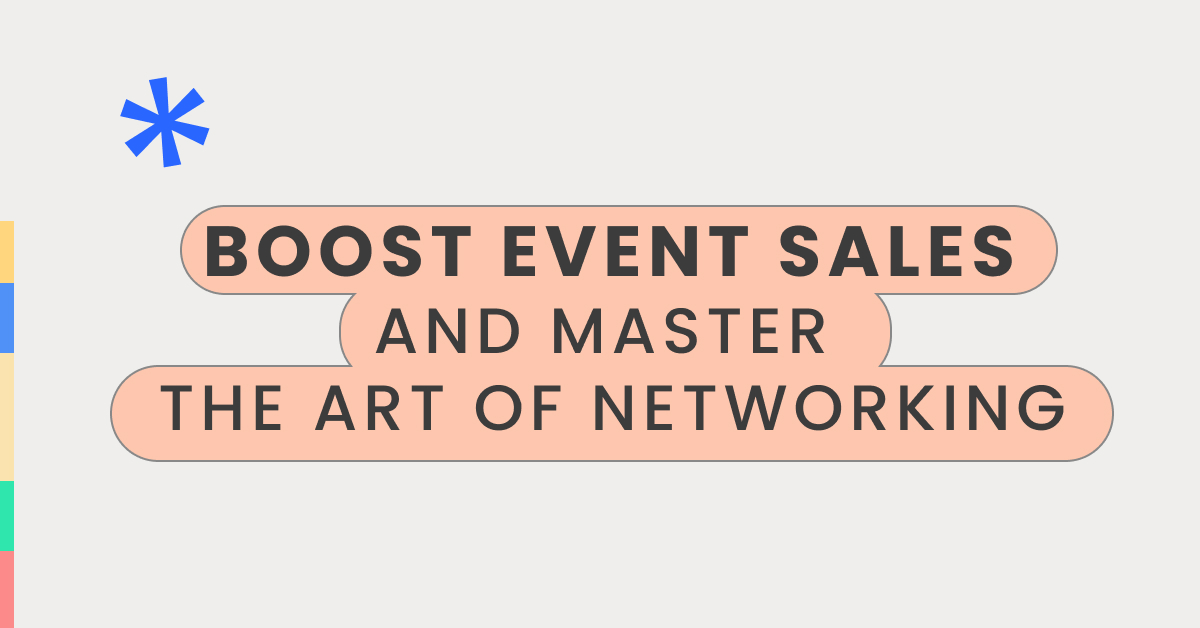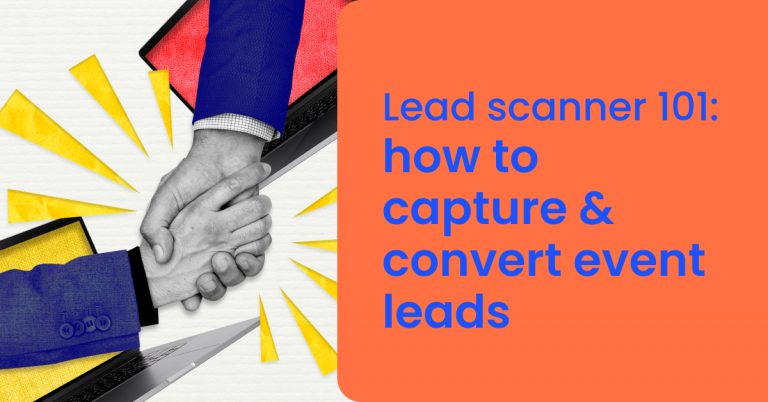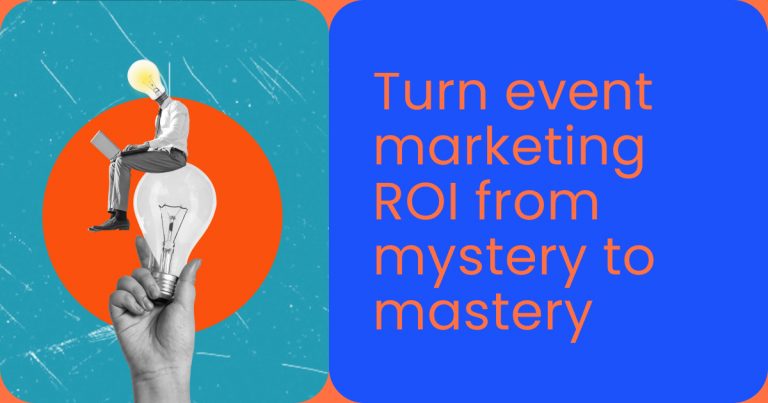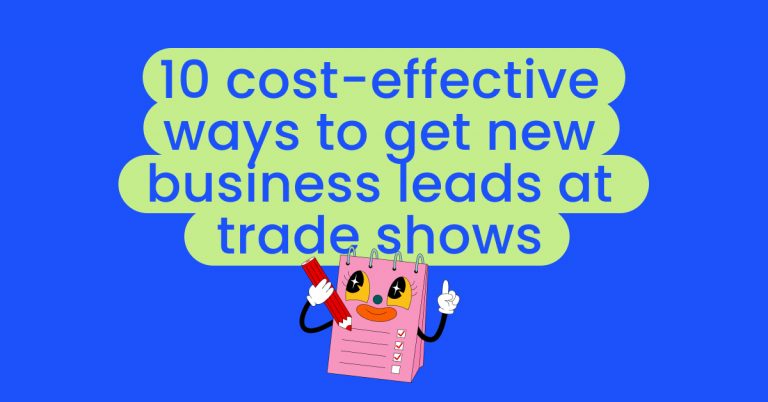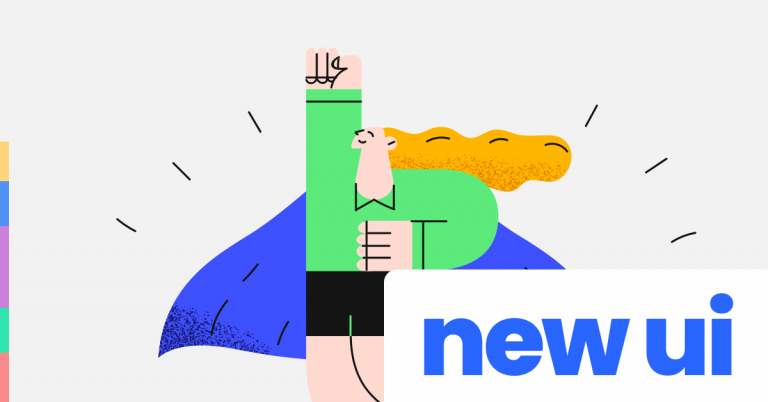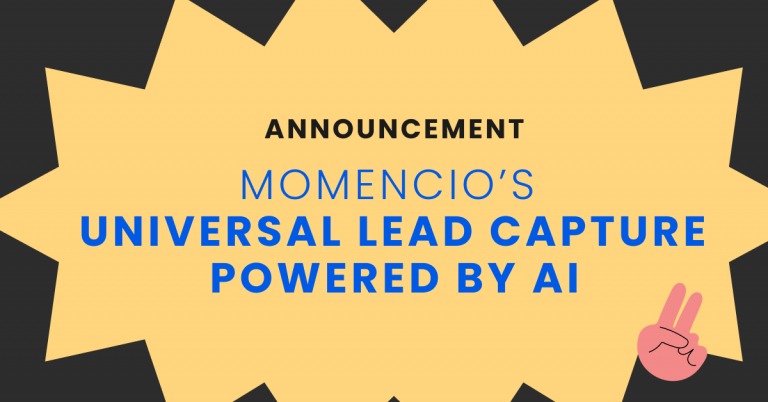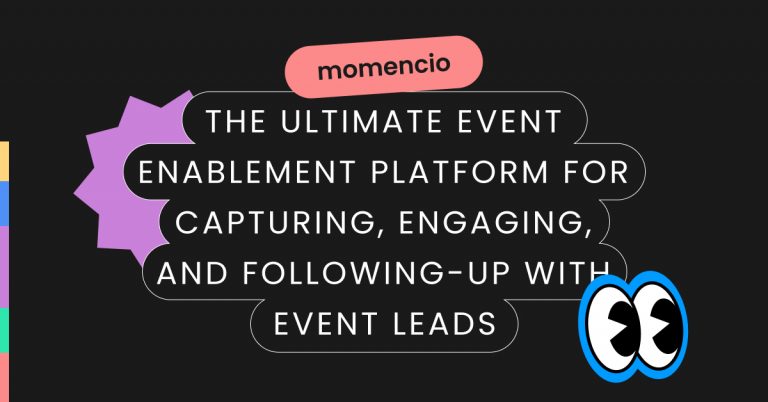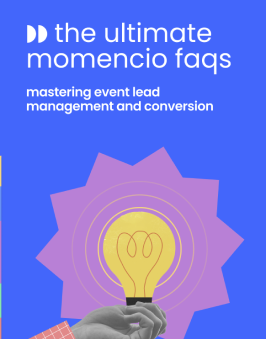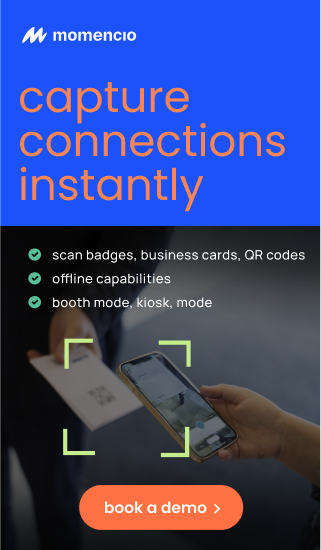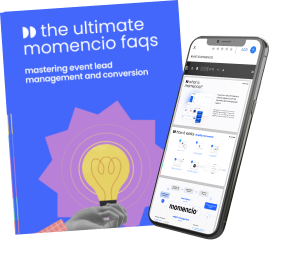Introduction
When it comes to event sales, networking is not just a bonus—it’s the main event. Over 67% of business leaders said that face-to-face interactions, particularly at conferences and trade shows, are crucial to closing deals and maintaining long-term client relationships. Yet, many event sales representatives approach these opportunities with a mindset of collecting business cards instead of building lasting relationships. And that’s where most fail.
If you are relying solely on a “pitch-first” approach, you’re missing out on the real power of event networking. These events—whether they’re trade shows, conventions, or expos—are not just about handing out business cards. They are about creating connections that eventually lead to conversions and long-term partnerships.
But here’s the challenge: with hundreds of booths, thousands of attendees, and constant distractions, how do you make sure you stand out? How do you become the person people want to talk to, not the one they avoid?
This article will walk you through a proven strategy for mastering networking at events, mixed with actionable, tactical advice for sales representatives. By the end, you’ll be equipped to not only maximize your networking potential but also turn those interactions into valuable business relationships and ultimately, sales.
Let’s get started on turning your event sales approach into a networking powerhouse that builds trust and drives revenue.
How to Maximize Event Sales Through Networking at Conferences
Conferences, trade shows, and expos are prime opportunities for event sales representatives to build relationships and close deals—but the key lies in how you approach networking. Networking at events isn’t just about collecting business cards; it’s about forming connections that lead to long-term business growth. Here’s how to make the most of it.
Why Conferences Are So Powerful for Event Sales
When you attend a conference, you’re entering an environment full of potential leads who are actively looking for solutions. The attendees at these events are decision-makers and influencers who come with the intention of discovering products and services that address their pain points. This creates an ideal environment for event sales representatives to engage directly with prospects.
At conferences, you also have the advantage of face-to-face interactions—something that is increasingly rare in the digital world. There’s something about in-person meetings that fosters trust and rapport faster than any email or phone call ever could. For event sales representatives, this is your opportunity to engage prospects on a more personal level, understand their needs in real-time using event insights, and establish yourself as a trusted resource.
How Event Sales at Conferences Differ from Regular Sales
Event sales operate in a fast-paced environment, where your window to make an impact is short. Unlike traditional sales cycles, where you might have weeks to nurture leads and build trust, conferences offer just minutes to make an impression. Your ability to quickly identify your prospect’s pain points and demonstrate how your solution fits is what separates the successful from the rest.
Sales representatives at conferences need to be ready to act quickly—whether that’s in initiating a conversation, responding to a question, or securing a follow-up meeting on the spot. Time is limited, and you’re competing with other companies for the same audience’s attention, so being prepared to deliver value immediately is critical.
The Power of Face-to-Face Connections
While digital marketing and virtual meetings are great for building initial awareness, nothing beats face-to-face communication when it comes to closing deals. In-person interactions provide a chance to read body language, gauge interest, and adapt your approach in real time. This is where trust is built, and trust is what converts a prospect into a client.
At a conference, you’re not just introducing a product or service—you’re introducing yourself. The impression you make in these interactions will have a lasting impact on whether or not that prospect chooses to do business with you down the line. Networking at events gives you the chance to create that personal connection that can lead to long-term sales.
How to Prepare for a Conference to Boost Your Event Sales
The key to crushing your event sales goals starts long before you show up at the conference. Winning at a trade show or expo doesn’t happen by accident—it’s all in the prep work. Here’s how you can make sure you’re walking into the event with a clear game plan.
-
Know Your Targets: Research, Research, Research
You wouldn’t walk into a meeting with a top prospect without doing your homework, right? The same rule applies to trade shows. Before you attend, take the time to research the attendees. Who’s going to be there? Who are the decision makers? What companies or industries align with your product or service?
Here’s a simple 3-step research process to help:
-
- Find out who’s attending: Many events release attendee lists or give you access to event apps where you can see who’s registered. Make a hit list of the top people you want to meet.
-
- Leverage LinkedIn: Check out attendee profiles and make connections before the event. Engage with their posts, learn about their roles, and build rapport before you even meet.
-
- Know their pain points: Read up on the key challenges facing their industry. The more specific you are about how you can help solve their problems, the better your chances of making a memorable impression.
-
Set Clear Goals for Networking Success
Here’s the deal: walking into a conference without goals is like walking into the gym without a workout plan—you’re just wandering around aimlessly. To make the most of your time, set concrete goals for who you want to meet and what you want to achieve.
Ask yourself:
-
- How many quality conversations do I want to have?
- Which sessions or workshops will attract my ideal prospects?
- What’s the best outcome from each conversation? (A meeting? A demo? A referral?)
Once you have your answers, you’ll be able to focus your efforts instead of spreading yourself too thin.
-
Prepare Your Pitch: But Don’t Just Sell
Let’s face it: nobody wants to feel like they’re being pitched right off the bat. Your goal should be to make meaningful connections, not just reel off product features. The way you approach these conversations can make all the difference. Here’s how to prep:
-
- Create an elevator pitch that’s more about the prospect than about your product. Think “How can I solve your problem?” instead of “Here’s what we do.”
-
- Practice your icebreakers: Instead of the standard “What do you do?” try something more engaging, like “What brought you to this event?” or “What challenge are you hoping to solve here?”
-
- Be ready with stories: Facts tell, stories sell. Have a couple of quick success stories on hand that demonstrate how your solution helped a similar company.
-
Arm Yourself with the Right Tools
Having the right tools in place can give you a serious edge at conferences. Make sure you’re not walking in empty-handed. Here’s what to have in your event toolkit:
-
- Business cards: Trust us on this one (You’ll thank us later). Make sure they’re professional and easy to scan.
-
- Event app: Most conferences have lead capture apps that help you capture contact details and network. Use them to capture leads, track engagement, and share collaterals with your prospects.
-
- Digital assets: Have brochures, case studies, or sales sheets ready on your event engagement app on phone or tablet. People are more likely to engage with multimedia content than endless talking.
-
- Follow-up plan: Don’t leave follow-up to chance. Plan out your post-event strategy in advance—whether it’s sending personalized emails or setting meetings.
How to Build Rapport Quickly at Trade Shows and Conferences
Networking at a conference is like speed dating—you’ve got a limited window to make a great first impression. So, how do you make sure you stand out and build instant rapport with prospects? Here’s a simple, step-by-step method to help you connect and engage without coming across as just another salesperson.
-
Smile and Make Eye Contact (Seriously)
It might sound basic, but the quickest way to make someone feel comfortable is to smile and make genuine eye contact. People are wired to respond positively to a friendly face. A confident, approachable demeanor breaks down barriers and sets the tone for a meaningful conversation. Plus, it instantly makes you more memorable.
#ProTip: Smiling while you talk on the phone helps too—it changes your tone and energy, making you more engaging even when you’re not face-to-face.
-
Use Their Name—It’s Personal
Ever notice how much you like hearing your own name? That’s no accident—people love to feel seen and acknowledged. As soon as you’re introduced, make a point of repeating the person’s name. It creates an instant connection and shows you’re paying attention.
- Start with something simple: “Great to meet you, Sarah.”
- Throughout the conversation, use their name naturally: “So, Sarah, what’s been your experience with this type of solution?”
This small touch personalizes the interaction and makes it clear that you’re engaged.
-
Lead with Curiosity, Not Your Pitch
The biggest mistake sales representatives make is diving straight into their pitch. Instead, start by asking open-ended questions that show genuine interest in the other person. People love talking about themselves, so give them that chance before you even mention your product.
Here are some easy conversation starters:
- Did you catch any good sessions today?
- What’s the big focus for your team right now?
- There’s so much happening in [specific industry] right now—lots of exciting opportunities. Is there a specific area you’re looking to improve right now?
- This event always brings in such a diverse crowd—great for hearing new perspectives. What’s been on your radar lately?
These questions aren’t just icebreakers—they help you gather insights on what your prospect cares about, allowing you to tailor your pitch later in the conversation.
-
Mirror Body Language and Tone
Ever notice how people unconsciously mimic each other’s body language when they’re engaged in conversation? It’s called mirroring, and it’s a powerful technique to establish rapport quickly. If your prospect is animated and speaking with lots of energy, match that tone. If they’re calm and reserved, adopt a more relaxed approach.
By mirroring their tone, posture, and energy level, you create an unspoken sense of connection that makes the other person feel more comfortable and understood.
#ProTip: Be subtle—overdoing it can come off as insincere. The goal is to reflect their vibe naturally, not mimic them exactly.
-
Share a Quick Story to Build Trust
Stories are one of the fastest ways to build trust and make your message stick. After asking questions and listening to their challenges, find a natural way to weave in a short story that shows how you’ve helped someone with a similar problem.
Keep it brief—no one wants to hear a drawn-out sales pitch. A quick success story shows you understand their situation and have the experience to help.
Example: It’s interesting, we worked with [existing client operating in the same industry or client with a similar use case] recently, and they were dealing with something similar. Once we understood their challenge with [list out the challenges. Don’t dwell too long here.], we helped them streamline the process by [your solution]. It ended up making a big difference for them.
-
Close with an Action, not a Goodbye
Once you’ve built some rapport and established a connection, don’t just say goodbye and walk away. Close every conversation with a clear next step. Whether it’s scheduling a follow-up call, inviting them to a demo, or connecting on LinkedIn, make sure there’s an action item to keep the conversation going.
Example: “It sounds like there’s a lot we could discuss further. Would you be open to scheduling a quick follow-up call next week to dive deeper?”
By ending the conversation with action, you leave the door open for a continued relationship—and that’s where the real sales magic happens.
Event Sales Networking Strategies That Convert Leads into Customers
You’ve got your foot in the door and built rapport—now it’s time to turn those promising conversations into real business opportunities. The difference between a casual chat and a long-term client relationship comes down to how you navigate that conversation. Here are the key networking strategies that will help you move the needle from connections to conversions.
-
Focus on Solving, Not Selling
When the conversation starts moving toward your product or service, resist the urge to go straight into sales mode. Your goal at this stage is to identify the prospect’s pain points and offer a solution that feels tailor-made for their specific challenges.
-
- Start with something like: Based on what you’ve mentioned, it sounds like you’re trying to solve [challenge]. Does that align with what you’re focused on right now?
-
- Once you’ve identified the problem, position your solution as the answer: We worked with a team facing a similar challenge, and here’s how we helped them simplify the process.
This approach shows that you’re genuinely interested in solving their problem—not just selling them a product.
-
Personalize Your Approach
Remember: People buy from people they trust. Every interaction should feel tailored to the person in front of you. Don’t use a canned pitch—use insights from your conversation to shape your offer.
-
- Mention something specific from your earlier chat: You mentioned earlier that your team is struggling with [specific challenge]. Here’s how we’ve helped others in your position.
-
- Make it feel like a natural continuation of the conversation rather than a sudden shift into pitching.
This makes the prospect feel like you’ve been listening carefully and that your solution is relevant to their situation.
-
Create Urgency Through Value, Not Pressure
There’s a difference between creating urgency and applying pressure. Pressure leads to pushback, but showing the value they’ll miss out on creates a natural sense of urgency.
-
- Frame it like this: If we could help you reduce [problem], what would that mean for your team’s efficiency over the next few months?
-
- Follow it up with a quick win: We typically see teams improve [specific metric] within the first [timeframe].
This puts the emphasis on how the value impacts their results rather than forcing them into a decision on the spot.
-
Use Storytelling to Connect
Don’t underestimate the power of a well-timed story. Instead of listing off features, tell a quick story that demonstrates your solution in action. This makes the benefits more relatable and memorable.
Example: I was working with a company that was facing almost the exact same problem as you. Once we implemented [solution], they were able to [specific result]. It’s been a game changer for them.
Stories help prospects visualize success and see how your solution can fit into their world without you having to pitch directly.
-
Don’t Close the Deal—Close the Next Step
At the end of the conversation, you don’t need to close the entire deal. Instead, focus on getting the prospect to commit to the next step. This keeps the momentum going without overwhelming them.
-
- Suggest a clear next step: It sounds like this is worth exploring further. How about we set up a quick call next week to dive into the details?
-
- Or offer a demo or follow-up that feels low-pressure: I’d love to walk you through how we’ve helped other teams like yours. Are you open to a quick demo?
The goal is to keep them engaged and move the conversation forward without making them feel like they’re locked into a decision too soon.
Networking at events is about more than just handing out business cards—it’s about building meaningful connections and using those moments to understand the person’s needs. When you shift from selling to problem-solving, personalize your approach, and focus on moving the conversation forward step by step, you’ll find that your event leads quickly turn into valuable customers.
Top 5 Networking Mistakes Sales Representatives Make at Conferences and How to Avoid Them
You’ve prepped, researched your leads, and brought your A-game to the event. But even the most seasoned sales representatives can slip up when it comes to networking.
Here are the top 5 mistakes sales representatives make at conferences—and how you can avoid them.
Read: Top 5 Post-Event Engagement Mistakes Event Planners Make and How to Avoid Them
Mistake #1: Talking More Than Listening
You’re at the event to sell, right? Wrong. You’re there to understand your prospect’s needs first. The fastest way to turn someone off is to dominate the conversation. If you’re doing all the talking, you’re missing the opportunity to learn about their pain points.
Fix: Aim for an 80/20 rule—listen 80% of the time, talk 20%. Ask open-ended questions and let them tell you what they need.
Mistake #2: Being Too Aggressive with Your Pitch
Nothing shuts down a conversation faster than a hard pitch right out of the gate. People don’t want to be sold to—they want to connect. If you lead with your product instead of focusing on the person, you’ll come across as pushy.
Fix: Focus on building rapport first. Make it about them: “What challenges are you working through right now?” Your pitch should come naturally once you understand their needs.
Mistake #3: Not Following Up
You had a great conversation, exchanged contact details, and made a solid connection—then you forgot to follow up. This is where most sales opportunities fall through the cracks. Prospects get busy, and without a follow-up, they’ll forget about you.
Fix: Follow up within 24-48 hours. A simple, personalized email referencing your conversation will keep you top of mind. Don’t leave it to chance.
Mistake #4: Not Being Prepared for Spontaneous Conversations
Conferences are unpredictable, and some of the best networking moments happen in hallways, at coffee stands, or in between sessions. If you’re not ready to dive into a conversation on the fly, you’ll miss out on high-value connections.
Fix: Have your elevator pitch ready and be prepared to pivot based on the situation. You don’t need a full pitch—just a clear, concise explanation of how you can help.
Mistake #5: Collecting Business Cards Without a Plan
Grabbing as many business cards as possible might feel productive, but if you’re not engaging in meaningful conversations or creating a plan for follow-up, those cards will sit in a drawer collecting dust.
Fix: Quality over quantity. Focus on a few key connections and have a clear next step in mind. Whether it’s a follow-up meeting or a demo, don’t leave the conversation without a plan. momencio helps you swiftly scan and store contact details from business cards and badges.
Networking isn’t just about making connections—it’s about making the right ones and nurturing them properly. Avoid these common mistakes, and you’ll see your event sales efforts start to pay off in a big way. Listen more, pitch less, and always have a plan for follow-up. Do this, and you’ll stand out from the crowd at any conference.
Best Follow-Up Strategies to Turn Event Connections into Sales
You’ve made the initial connection at the event, built some rapport, and maybe even exchanged contact details. Now comes the real work—following up. The truth is, most sales are lost not because of a bad conversation, but because of poor follow-up. Here’s how to make sure you stay top of mind and keep the momentum going after the event.
Step #1: Don’t Wait—Follow Up Within 24-48 Hours
Timing is everything when it comes to follow-up. Strike while the iron is hot and get in touch with your prospects within 24 to 48 hours after the event. Any longer, and the connection starts to fade.
- Send a personalized email thanking them for the conversation. Mention something specific from your chat to show that you were listening:
It was great talking about [specific topic or challenge] at the event. I’d love to explore how we can help you with [relevant solution].
- If they agreed to a meeting or demo, confirm the next step:
Looking forward to our meeting next Tuesday—let me know if there’s anything you’d like me to prep ahead of time.
Step #2: Add Value Before Asking for Anything
Before you ask for a follow-up call or meeting, give them something of value. This keeps the conversation feeling natural and shows that you’re there to help, not just sell.
- Share a relevant resource, like a case study, whitepaper, or blog post that speaks to the challenges they mentioned during your conversation.
Example: I came across this article on [topic] and thought it might resonate with the challenge you mentioned around [specific problem]. Let me know if this sparks any ideas for how we can collaborate.
This subtle approach builds trust and positions you as someone who’s genuinely interested in solving their problem, not just closing a sale.
Step #3: Keep It Short and Personal
When following up, avoid long, drawn-out emails or overly formal language. Short and personal is the way to go.
- Keep your emails conversational and direct. A couple of sentences that reference your earlier conversation and highlight why it’s worth reconnecting are all you need.
Example: I was thinking about our conversation regarding [topic], and I believe we could make a big impact on [specific challenge]. Let’s schedule that follow-up to discuss it further.
Nobody wants to read long-winded emails, especially after a busy event. Brevity is your friend.
Step #4: Focus on Next Steps, Not the Sale
The goal of the follow-up isn’t to close the deal immediately—it’s to keep the conversation moving forward. Make sure each follow-up has a clear next step that feels natural.
- Suggest a demo, follow-up meeting, or a deeper conversation about their pain points. Don’t push for a decision right away.
Example: Let’s set up a quick call next week to dive deeper into how we can help you address [specific challenge].
By keeping it low-pressure and focused on discovery, you maintain the connection without overwhelming the prospect.
Step #5: Stay Consistent Without Being Pushy
It’s a fine line: You want to be persistent but not annoying. If you don’t hear back after your first follow-up, don’t give up right away. Give it some time (usually a week), and then send a gentle reminder.
Example: I wanted to quickly follow up on my last message—still interested in connecting to discuss [specific topic]?
- If you still don’t hear back, wait another week before a final nudge:
Just following up to see if this is still something you’d like to explore. Let me know if you’d like to find a time to chat—happy to work around your schedule!
This approach keeps you top of mind without making the prospect feel pressured.
Effective follow-up is what separates event sales rockstars from the rest. It’s all about timing, adding value, and keeping the conversation going without overwhelming your prospect. When you follow up in a way that feels personal, thoughtful, and consistent, you’ll turn those event connections into long-term customers.
Build Relationships, Build Sales
Conferences and trade shows aren’t just about making quick connections—they’re about building lasting relationships that drive long-term sales. If you’ve mastered the art of networking, you’re not just gathering leads, you’re planting seeds for future growth.
Here’s what we covered:
- Prepare like a pro: The groundwork you lay before the event determines how successful you’ll be. Know your audience, plan your conversations, and set clear goals.
- Focus on building rapport: Networking is about making genuine connections, not delivering pitches. Listen more, talk less, and make it personal.
- Follow up effectively: Don’t let valuable connections slip away. Follow up quickly, keep it short, and add value before you ask for anything.
- Avoid common mistakes: Talk less, listen more, and never collect business cards without a plan.
- Play the long game: Keep the conversation going after the event. Stay in touch, nurture your leads, and focus on providing ongoing value.
Remember, event sales is all about creating opportunities that extend beyond the conference floor. Every connection is a potential client, but only if you treat them like a partner, not just a lead.
Ready to turn your event sales into lasting success? Let momencio help you streamline your follow-up process and manage event experiences like a pro. Book a demo!
FAQs
- How can I improve my networking skills at conferences?
- Focus on listening more than talking. Prepare in advance by researching key attendees, and approach each conversation with curiosity. Use personalized conversation starters that engage people on their challenges rather than pitching immediately. Always follow up with a clear next step.
- What’s the best way to follow up after a conference?
- Send a personalized email within 24-48 hours. Reference something specific from your conversation, offer value (such as a relevant article or case study), and suggest a low-pressure next step like a call or demo. Don’t let the lead go cold—use email, LinkedIn, and even a phone call if needed to keep the conversation alive.
- How do I avoid being too salesy during networking?
- Shift the focus from selling to solving. Ask open-ended questions about their challenges and listen carefully. Use those insights to frame your product as the solution, but only once you’ve established trust and rapport. The goal is to show that you understand their needs, not just push your product.
- How many people should I aim to connect with at a conference?
- Quality over quantity. It’s better to have 5-10 meaningful conversations than to collect dozens of business cards. Focus on building deeper connections with key prospects who are more likely to convert into long-term clients. Each conversation should have a clear purpose and follow-up plan.
- What tools can help me manage leads and follow-ups after an event?
- Tools like momencio can streamline your follow-up process by managing your leads, tracking interactions, and helping you send personalized follow-up emails. This ensures that no lead slips through the cracks and makes it easier to maintain a relationship long after the event is over.
Interesting Facts from Research
- 67% of leaders believe that in-person meetings are crucial to long-term business relationships. Face-to-face connections at conferences offer a significant advantage over digital communication.
- 92% of trade show attendees are there to evaluate new products and services, making them prime prospects for event sales representatives.
- 65% of people say a face-to-face conversation is the most impactful factor in their buying decision at a trade show or conference.
- Face-to-face requests are 34 times more likely to result in a positive response compared to emails.
